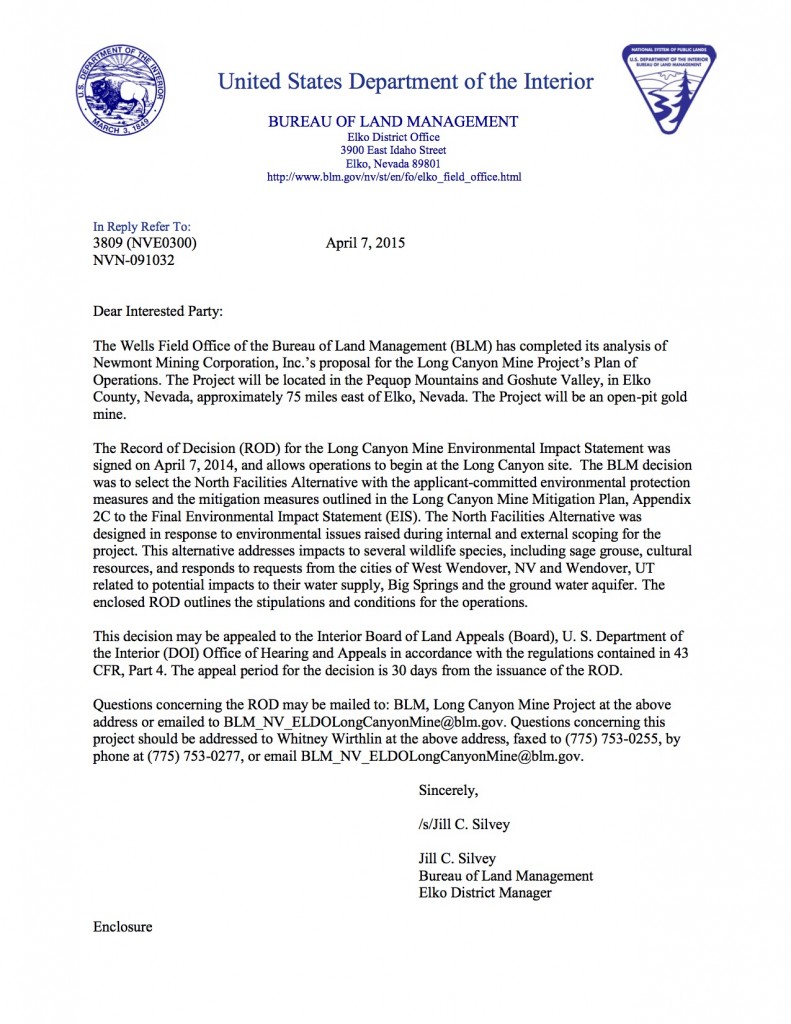The long anticipated Long Canyon Mine project cleared its final hurdle to begin construction with Bureau of Land Management issuing its Record of Decision this week.
According to a The Bureau of Land Management press release (BLM), the Wells Field Office of the Elko District issued the Record of Decision for Newmont Mining Corporation’s Long Canyon Mine Project to be located on the eastern side of the Pequop Mountain Range in Elko County, about 30 miles east of Wells and 30 miles west of Wendover.
 The decision allows the mining operator to construct and operate a new heap leach gold mine that would consist of one open pit, one heap leach pad, a waste rock storage facility, a tailings storage facility, a natural gas pipeline from the existing Ruby Pipeline, on-site power generation plant and other ancillary facilities. The associated disturbance would be approximately 1, 707 acres of public land, including 480 acres of split estate lands of federal surface and private subsurface.
The decision allows the mining operator to construct and operate a new heap leach gold mine that would consist of one open pit, one heap leach pad, a waste rock storage facility, a tailings storage facility, a natural gas pipeline from the existing Ruby Pipeline, on-site power generation plant and other ancillary facilities. The associated disturbance would be approximately 1, 707 acres of public land, including 480 acres of split estate lands of federal surface and private subsurface.
 Expected to take two years to build the initial project mine construction is expected to employ between 300 and 500 workers. According to Mary Korpi, Newmont’s Director of External Relations the project should be in full swing by summer.
Expected to take two years to build the initial project mine construction is expected to employ between 300 and 500 workers. According to Mary Korpi, Newmont’s Director of External Relations the project should be in full swing by summer.
Already the mine’s impact has been felt albeit slightly in both Wendover and Wells.
“We have seen some impact already,” said Wells Mayor Layla Walz. “Most of the vacant real estate has been bought. And there has been a noticeable increase of interest by businesses in locating to Wells.”
Walz’ observations were echoed by Wells City manager Jolene Supp, West Wendover City Clerk Anna Bartlome and Wendover,Utah Mayor Mike Crawford. All stated that their respective towns had seen an economic bump in the last six to nine months.
Everyone but Crawford attributed the upswing to the new mine.
“Right now we are seeing the impact of the smaller mining projects to the south,” Crawford said Wednesday. “We will probably see much more of an impact later on when the construction starts. But I believe Wells could benefit first then Wendover.”
If Crawford’s prediction is right Wells would be grateful.
 With less than a 1,000 population Wells was hard hit not only economically but also suffered biblical disasters like the earth quaked of 2008 and the range wild fires of 2006. Most of its historic down town was destroyed and even the two local brothel hit hard times.
With less than a 1,000 population Wells was hard hit not only economically but also suffered biblical disasters like the earth quaked of 2008 and the range wild fires of 2006. Most of its historic down town was destroyed and even the two local brothel hit hard times.
“It is good to be able to welcome the good times especially after all we have been through,” Walz said.
While not suffering anywhere near Wells, Wendover, Utah and West Wendover Nevada could also use some large scale economic good news too.
West Wendover, Nevada has seen a general decline in the number of small businesses from a high of around 300 in 2003 to about half that a decade later.
With a population less than half of West Wendover, Wendover, Utah boasts about 180 business including 110 locally owned or operated said City Clerk Mariah Murphy.
 According to a Newmont press release the first phase of development consists of an open pit mine and heap leach operation with expected gold production of between 100,000 and 150,000 ounces per year over an eight year mine life at an estimated all-in sustaining cost of between $500 and $600 per ounce. At current gold prices, the project is expected to generate around $100 million in EBITDAii annually, beginning in 2017.
According to a Newmont press release the first phase of development consists of an open pit mine and heap leach operation with expected gold production of between 100,000 and 150,000 ounces per year over an eight year mine life at an estimated all-in sustaining cost of between $500 and $600 per ounce. At current gold prices, the project is expected to generate around $100 million in EBITDAii annually, beginning in 2017.
“Taking a phased approach to developing Long Canyon gave us the means to lower development capital to between $250 million and $300 million; generate an internal rate of return of about 17 percent at current gold prices; and reduce the payback period to just over four years after first commercial production, which we expect to reach in the first half of 2017. I’m confident that we have the engineering, ore body knowledge and community agreements in place to deliver this project safely, on time and on budget,” said Gary Goldberg, President and Chief Executive Officer.
The project will be funded through free cash flow and available cash balances, and leverage Newmont’s existing equipment, infrastructure and personnel. Capital expenditures will be allocated roughly equally in 2015 and 2016, with minimal spending in 2017.

